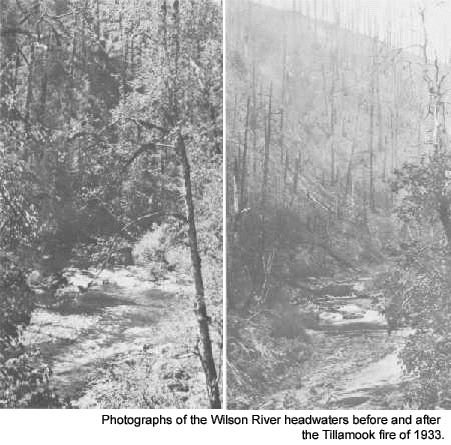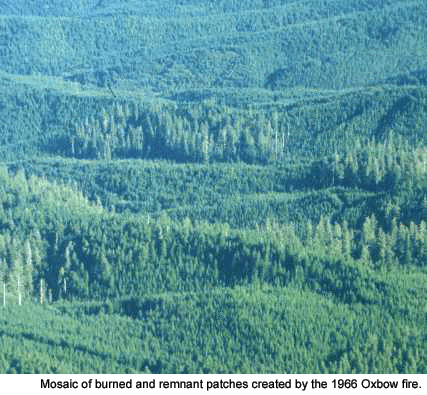|
Characterizing historical
fire regimes and landscape dynamics of Coast Range forests
Michael C. Wimberly and Thomas A. Spies, Pacific
Northwest Research Station, USDA Forest Service
 Forest
landscape patterns in the Oregon Coast Range have changed
considerably since the arrival of Euro-American settlers in
the 19th century. Extensive timber harvesting has reduced
amounts of old forests and increased fragmentation in the
current landscape. These widespread changes have led to concern
for the viability of populations of many native species. Because
of limited knowledge and resources, developing and implementing
individual management plans for every species is not feasible.
An alternative approach involves managing for forest patterns
and dynamics similar to the historical range of variability
that existed in pre-settlement landscapes. This type of management
is essentially a “coarse-filter” method, which assumes
that maintaining a range of forest types similar to historical
distributions will sustain most of the native species that
depend on these habitats. Forest
landscape patterns in the Oregon Coast Range have changed
considerably since the arrival of Euro-American settlers in
the 19th century. Extensive timber harvesting has reduced
amounts of old forests and increased fragmentation in the
current landscape. These widespread changes have led to concern
for the viability of populations of many native species. Because
of limited knowledge and resources, developing and implementing
individual management plans for every species is not feasible.
An alternative approach involves managing for forest patterns
and dynamics similar to the historical range of variability
that existed in pre-settlement landscapes. This type of management
is essentially a “coarse-filter” method, which assumes
that maintaining a range of forest types similar to historical
distributions will sustain most of the native species that
depend on these habitats.
 Better
assessments of historical landscape patterns and dynamics
are needed to provide a baseline for comparing current conditions,
and to possibly serve as a basis for developing new forest
management strategies. Most historical landscape assessments
to date have not considered the spatial and temporal variability
characteristic of natural systems, instead focusing on single
points in recent time or assuming steady-state conditions.
However, the assumption of a static or equilibrium landscape
is unrealistic in ecosystems characterized by large, infrequent
disturbances Large wildfires, for example, were ubiquitous
in pre-settlement Coast Range forests. These disturbances
created a shifting mosaic in which the amounts and spatial
patterns of seral stages continually fluctuated. It is therefore
necessary to characterize a range of possible landscape patterns
over a long time period rather than simply estimate static
conditions. Better
assessments of historical landscape patterns and dynamics
are needed to provide a baseline for comparing current conditions,
and to possibly serve as a basis for developing new forest
management strategies. Most historical landscape assessments
to date have not considered the spatial and temporal variability
characteristic of natural systems, instead focusing on single
points in recent time or assuming steady-state conditions.
However, the assumption of a static or equilibrium landscape
is unrealistic in ecosystems characterized by large, infrequent
disturbances Large wildfires, for example, were ubiquitous
in pre-settlement Coast Range forests. These disturbances
created a shifting mosaic in which the amounts and spatial
patterns of seral stages continually fluctuated. It is therefore
necessary to characterize a range of possible landscape patterns
over a long time period rather than simply estimate static
conditions.
We developed the Landscape Age-Class Dynamics Simulator
(LADS), to examine historical variability in the amounts of
forest seral stages in the Pacific Northwest. This computer
model simulates pre-settlement fire regimes using parameters
derived from dendroecological, paleoecological, and historical
studies. Results to date have emphasized the sensitivity of
landscape variability to the spatial scale of analysis and
showed that current amounts of old forest in the Oregon Coast
Range province are lower than expected under the pre-settlement
disturbance regime (Wimberly et al. 2000). We are currently
developing an enhanced version of the LADS model that is sensitive
to topography, as well as spatial and temporal variability
in vegetation and climate (Wimberly, in review). This new
simulator will be linked with models of plant and animal populations
to study the responses of various species to changes in the
disturbance regime.The animation at right illustrates predicted
landscape dynamics from a single model run, encompassing the
3000 years prior to Euro-American settlement. Because the
model is stochastic, this simulation should be viewed as a
general representation of landscape patterns and dynamics
rather than a precise prediction of landscape characteristics
at any given point in time.
Click or use browser
controls to run animation
References
Wimberly, M. C., Spies, T. A., Long, C. J., and Whitlock,
C., 2000. Simulating historical variability in the amount
of old forests in the Oregon Coast Range. Conserv. Biol.
14: 167-180.
Wimberly, M. C.,
in review. Spatial simulation of dynamics landscape mosaics
under historical fire regimes.
|